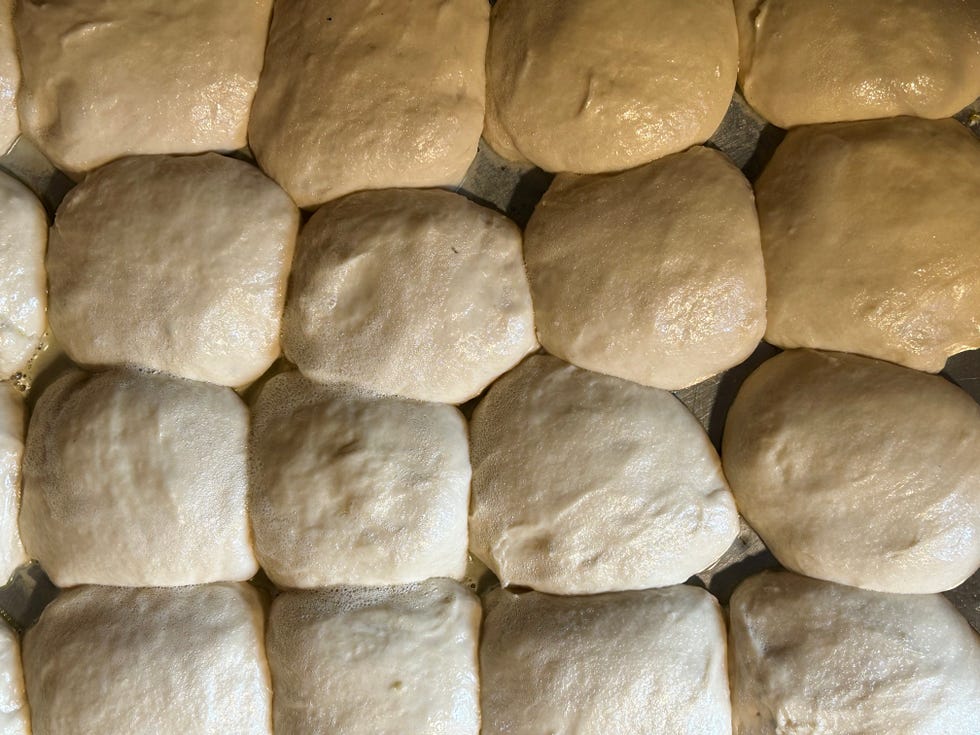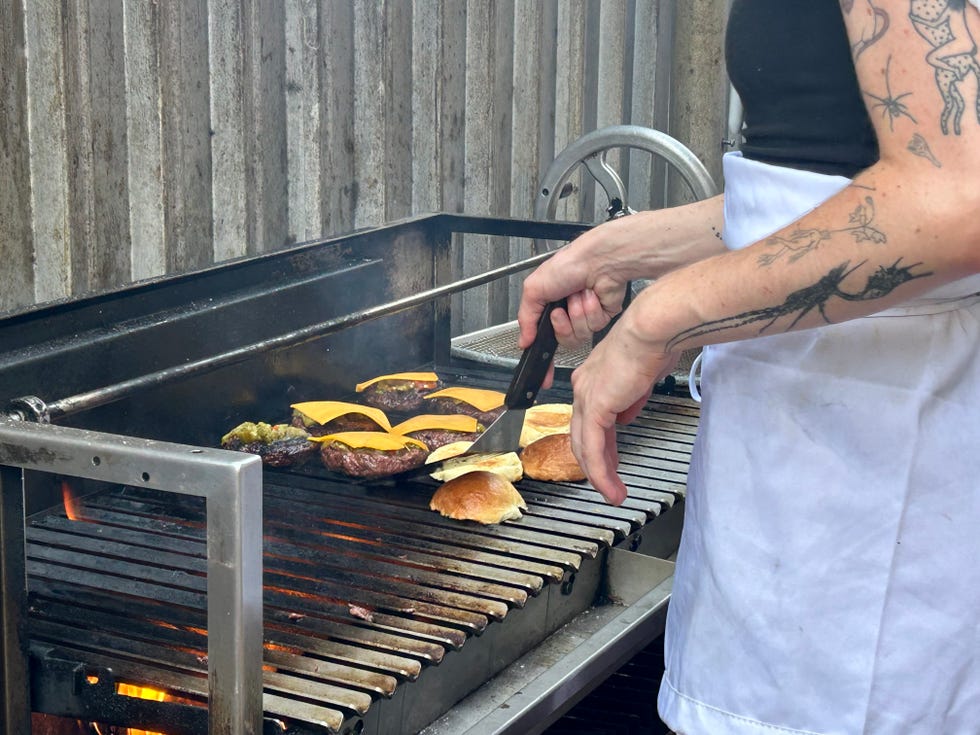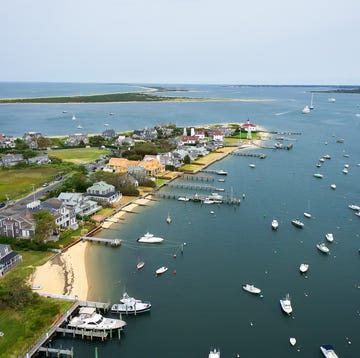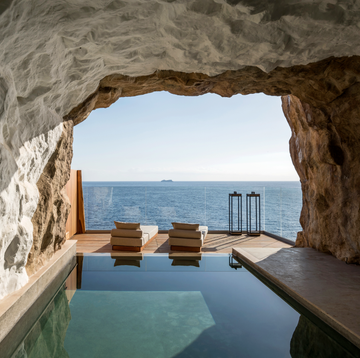When I first speak to chef Eric See of Brooklyn’s Ursula, it’s September 1 and the service fizzles in and out. He is driving with his dad, Jim, on an approximately 2,000-mile road trip that started in Albuquerque—the chef’s hometown—to put together his annual New Mexican Chile Roast, taking place four days later at the Meat Hook butcher shop in Brooklyn.
This marks the fourth year See has embarked on the quest to transport chiles directly from New Mexico to Brooklyn. In his home state, the annual green chile festival has been celebrated since the early 1970s. His version, which he describes as “a sensory cultural experience,” honors his heritage, the history of the chile, and queerness with joy and familial warmth.
By the time I’ve gotten a hold of See, he is passing through Dallas with 1,400 pounds of green chiles in tow from the Viramontes Farm in Deming, New Mexico. The Sees keep the AC maxed out, creating a makeshift highway refrigerator on wheels. The New Mexican green chile harvest is regional and seasonal—people buy chiles by the pound in ziplock or large trash bags, have them roasted (if they weren’t already), and then sit around the kitchen table together to peel them still warm.
Green chiles are an integral part of New Mexicans’ cultural identity; the pepper was born there, a creation of horticulturist Fabían García’s. New Mexicans tuck the chiles into burritos and gorditas, cook them down into stews, layer them in burgers, and so on. And at See’s restaurant Ursula—where most of the menu offerings boast green chile—they’re even made into a jam spread in the restaurant’s toothsome “sangwiches.”
For this year’s event, he invited Bleu Adams, a Mandan-Hidatsa-Diné chef of Southwestern cuisine and director of the organization Indigehub, to fly in from Provo, Utah. The two met at a James Beard boot camp to teach chefs about addressing issues like food systems, restaurant labor, and wages at the federal level, Adams tells me. After they met, See says, he instantly knew he wanted to cook with her. Their menu for this year’s festival features Navajo tacos and green chile cheeseburgers alongside beers from local Iranian woman-owned brewery Back Home. Here’s a peek behind the chile smoke at the preparation for this special event.
9:30 a.m., Tuesday, September 5
Today is the big day, the culmination of what ended up being a six-day road trip to bring some authentic New Mexico to Brooklyn. The day begins, naturally, with roasting chiles in barrel roasters. To my surprise, they aren’t Hatch chiles—one of the most popular varieties from New Mexico. See says that Hatch chiles are one of the state’s 12 regional varieties; his are machete (spicy!) and Big Jim (less spicy). On the first roasting shift are Elihu Jones, Nicky Yeager, and Tori Canning, who eventually begins packaging the produce. Roasting the chiles is necessary because, as See explains, their outer skin is plasticky and not palatable. But it causes them to lose water weight, so five pounds of fresh chiles weigh 3.9 pounds after roasting. They are sold in ziplock bags, in tradition with standard New Mexico practices.
1:30 p.m.
When I turn the corner of Brooklyn’s Graham Avenue, my nose knows I’ve arrived before my eyes do. The street is perfumed with a toasty vegetal waft, laced with a hint of spice from the chiles roasting in the barrels. The temperature is high in the 90s, and the air is swirling with charred bits of chile, a charcoal rain that we’re all instantly freckled by.
1:41 p.m.
When I catch up with See, he is carving kernels off of corncobs for esquites. He talks about horticulturist García’s impact on New Mexican cuisine and the green chile (pronounced “chili” in New Mexico). García worked to cultivate a chile that would peel more easily, be more suitable for canning, and, See says, appeal more to American palates—i.e., be less spicy.
Matador, the variety See uses for his green chile burgers, is a genetic child of the chile García would develop: New Mexico No. 9. Sounds like the name of a perfume.
See says this year, the matador chiles were smaller. The increasingly hot temperatures (hello, climate change) in New Mexico this year stressed the plants, causing them to produce more capsaicin than normal and stunting their growth.
2:48 p.m.
Twenty-two bags out of 40 have been roasted and bagged. The roaring of the propane tanks continues; so does the charcoal rain.
2:51 p.m.
More of the team has arrived, and they shift into the puzzle of setting up for service. Tables made from crates and squared wooden tops are being set up on the street and sidewalk.
3:50 p.m.
Maia Fernandez begins setting up the merch table, adorning it with a green chile tablecloth on a red backdrop.
4:00 p.m.
The grill for burgers is being fired up, and the stations are moving quickly.
Fry bread dough, made using Blue Bird Flour, is being portioned out by weight in little balls and prepared for service.
Chef Adams starts bringing the frying oil up to temperature.
On a Zoom call two days later, Adams recounts to me the violent history of fry bread, how her Diné ancestors were forced on a 300-mile march in 1864, their food sources were scorched and slaughtered, to what Adams describes as a concentration camp. Upon arriving at Bosque Redondo, New Mexico, they were given commodities such as flour, salt, lard, and sugar, the ingredients used to make fry bread.
“Some people see it as a food of oppression,” Adams says. “I prefer to see it as innovation and our contribution to Southwestern cuisine.”
4:22 p.m.
Twelve bags left out of 40 to roast.
Jim See—“Papa”—tells me they’ve been roasting about four to five bags per hour, which is approximately 160 to 200 pounds of peppers. One of the barrels gets moved onto the street, and the roasting continues, as the makeshift kitchen and chile processing stations make room for tables, seats, and the hungry mouths to come.
4:30 p.m.
’80s-inspired Ursula shirts featuring Eric’s grandma (the restaurant’s inspiration and namesake) are being folded and set up on the merch table. Behind the table are stacks upon stacks of ziplock bag stuffed with New Mexican green chiles.
Papa See sets up a table with burlap for chile preorder pickup.
Kory Wilson starts setting up the burger station, opening mild cheddar cheese packs—a cheese emblematic of New Mexico.
A line has started forming.
4:58 p.m.
There is a full line around the block. Eric holds a quick team meeting.
5:10 p.m.
Doors open, Papa See greets guests at the preorder chile pickup table, and a line for fry-bread tacos and burgers starts to move.
5:30 p.m.
Mariachi music begin to play, fry-bread tacos and burgers are being devoured, and roasted chiles continue to fill the air with their scent—the festival is in full production. And for a balmy afternoon in this corner of Bed-Stuy, New Yorkers get a little taste of a cherished New Mexican tradition.
Andrea Aliseda is a Mexican-American writer and vegan recipe developer based in Los Angeles, CA. Her published work appears in Whetstone, Bon Appetit, Epicurious, and more. Follow her for updates on Instagram at @andrea__aliseda and Twitter at @alisedaandrea.























